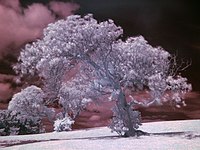
Back تصوير بالأشعة تحت الحمراء Arabic Fotografia infraroja Catalan Infračervená fotografie Czech Infrarotfotografie German Fotografía infrarroja Spanish Soojuspilt Estonian عکاسی فروسرخ Persian Lämpökuvaus Finnish Photographie infrarouge French Grianghrafadóireacht infridhearg Irish
| Alternative photography |
|---|
 |
Top: tree photographed in the near infrared range. Bottom: same tree in the visible part of the spectrum.


In infrared photography, the photographic film or image sensor used is sensitive to infrared light. The part of the spectrum used is referred to as near-infrared to distinguish it from far-infrared, which is the domain of thermal imaging. Wavelengths used for photography range from about 700 nm to about 900 nm. Film is usually sensitive to visible light too, so an infrared-passing filter is used; this lets infrared (IR) light pass through to the camera, but blocks all or most of the visible light spectrum (the filter thus looks black or deep red). ("Infrared filter" may refer either to this type of filter or to one that blocks infrared but passes other wavelengths.)
When these filters are used together with infrared-sensitive film or sensors, "in-camera effects" can be obtained; false-color or black-and-white images with a dreamlike or sometimes lurid appearance known as the "Wood Effect," an effect mainly caused by foliage (such as tree leaves and grass) strongly reflecting in the same way visible light is reflected from snow.[1] There is a small contribution from chlorophyll fluorescence, but this is marginal and is not the real cause of the brightness seen in infrared photographs. The effect is named after the infrared photography pioneer Robert W. Wood, and not after the material wood, which does not strongly reflect infrared.
The other attributes of infrared photographs include very dark skies and penetration of atmospheric haze, caused by reduced Rayleigh scattering and Mie scattering, respectively, compared to visible light. The dark skies, in turn, result in less infrared light in shadows and dark reflections of those skies from water, and clouds will stand out strongly. These wavelengths also penetrate a few millimeters into skin and give a milky look to portraits, although eyes often look black.
- ^ The Wood Effect results from the transparency of chlorophyll at wavelengths over 500 nm allowing light to be reflected within the plant cells. Normally the effect is invisible because so much green light is reflected by the foliage but it is possible to see the effect, albeit dimly, with the naked eye by looking through a 720 nm filter (or similar) on a sunny day and allowing your eye to adjust to the low light.
© MMXXIII Rich X Search. We shall prevail. All rights reserved. Rich X Search

